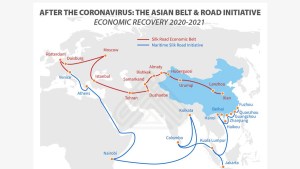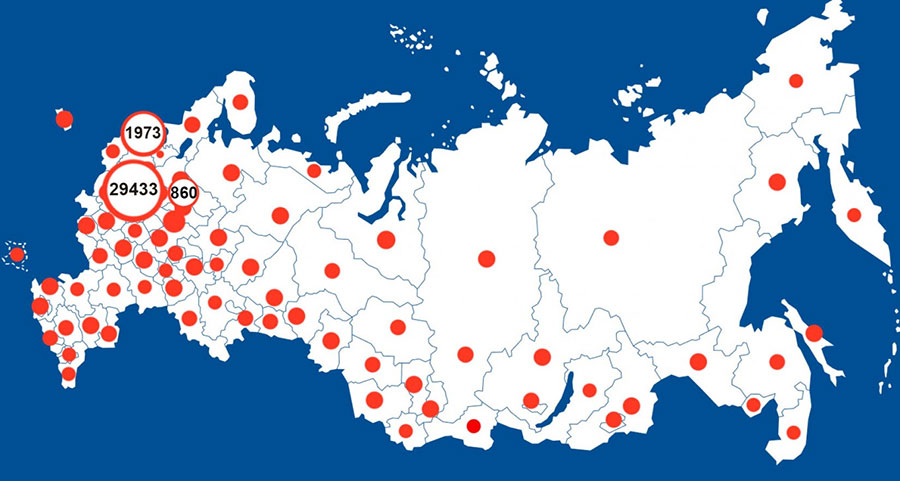Did China Spread The Coronavirus Along The Belt & Road Initiative?
Op/Ed by Chris Devonshire-Ellis
Some of the Western media have been playing up the role of China’s Belt & Road Initiative in the spread of the Covid-19 pandemic. Articles such as “The Chinese Virus Spread To The West On The New Silk Road” “One Belt, One Road, One Pandemic“ among others have tended to attribute the spread of the virus to China’s BRI. Is this true?
Given that the BRI is essentially a long list of infrastructure projects, mainly undertaken by Chinese SOEs, there are two ways in which the Covid-19 virus could have spread. One is by Chinese labourers introducing the virus into the regions where these builds are taking place, the other is the increased volume of human traffic using the infrastructure.
Much of the criticism and accusatory nature of these articles assumes that just the freight traffic volume has been responsible. There appears to be no evidence that Covid-10 can survive on a surface for very long – studies thus far indicate a 72 hour lifespan.
That’s long enough to risk infection on something picked up from your local store – which still remains an unlikely source of transmission – and effectively rules out infections being carried by freight. Most of the freight routes are just that – freight, not passenger.
Allegations of the Belt & Road Initiative spreading the virus must therefore be related to people transporting it. Yet passenger tickets along the Trans-Siberian and all other passenger routes through the Belt & Road into Kazakhstan and Russia were closed in early January, and remain closed to passengers.
While it is true that thousands of Chinese workers have been posted overseas to work of infrastructure projects, they are extremely well protected from the local societies they are working in. Chinese SOEs working overseas and deploying Chinese labour typically house them in temporary accommodation, set up as camps. They are monitored, not allowed access to local amenities and essentially corralled. Chinese food and drink is provided, and all necessities catered for. One simply does not see, apart from the occasional senior manager, Chinese workers overseas mixing with the local population. Besides – these workers are typically on 6-12 month deployments – none of them were in China when the outbreak began in Wuhan. Those that were have mostly now returned to China, leaving just a small number of admin and security staff behind.
One can also be sure that if Chinese overseas workers had been responsible for large numbers of infections, we would have heard about it.
Curiously, there are lessons here for normally strict Singapore, who omitted to spot the potential for mass-communal worker dormitories becoming a potential harbour for the virus. But this is exactly what has happened – migrant workers from Bangladesh and India – some fleeing the lockdown in India – have returned to work in Singapore. One of the largest worker dorms there accommodates an astonishing 22,000 people, and Singapore, from being a lockdown poster boy in terms of handling the outbreak, is recording new cases in excess of 1,000 a day. It will take the country some time to clear all that up. But these workers were not Chinese.
What is interesting is to note the spread of the virus in Russia, which has a 4,209 km border with China. Had there been any transmission of the virus from China, along the Belt & Road, it would have spread from the East, and headed West. Yet that is not what has happened.
Russia had relatively few cases of Covid-19, reporting just two in January and February. One was in Irkutsk, the other in Moscow, both recovered and appeared not to have spread the virus. However, the Russian school holidays, which run between 15th-24th February see a lot of Russians travel overseas, with Italy a favoured destination. From the end of February, cases began to be reported, with nearly all being returning Russian holidaymakers from Italy and other parts of Europe which at the time had not entered lockdown. With people feeling well and Russia not in lockdown either, the virus managed to get a hold.
A map of the Covid-19 infections across Russia today, courtesy of the Moscow Times shows how the virus is spreading from West to East, not from East to West.
China now also has a new cluster of Covid-19 infections, on the border with Russia. These are returning Chinese to Suifenhe, a wholesale goods market town close to the Russian border, who have come back home to China in order to escape the virus and lockdown in Moscow, where their main Moscow retail outlets are.
So did the Belt & Road Initiative help spread the virus to the West? No. But the great concern must be that as we have seen in Far East Asia and China, cross-border infections from returning nationals to their respective countries remain a huge infection threat, and any likely “second wave” of Covid-19 will almost certainly come from returnees who have not been properly registered, monitored, and quarantined.
Covid-19 recognizes no borders, nationalities or checkpoints. Any reopening of ports, airports, road and rail routes both on an internal and cross-border basis needs to be thoroughly thought through, regardless of any Belt & Road Initiative connection.
Related Reading
 After The Coronavirus: The Asian Belt & Road Initiative Economic Recovery 2020-2021
After The Coronavirus: The Asian Belt & Road Initiative Economic Recovery 2020-2021
 The Current Social & Economic Impact Of Covid-19 Upon The BRICS Nations
The Current Social & Economic Impact Of Covid-19 Upon The BRICS Nations
About Us
Silk Road Briefing is written by Dezan Shira & Associates. The firm provides strategic analysis, legal, tax and operational advisory services across Eurasia and has done since 1992. We maintain 28 offices throughout the region and assist foreign governments and MNC’s develop regional strategies in addition to foreign investment advice for investors throughout Asia. Please contact us at asia@dezshira.com or visit us at www.dezshira.com






